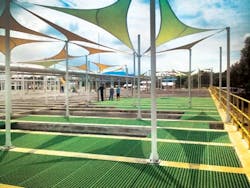The city of Jakarta in Indonesia is the largest metropolis in Southeast Asia. With a population of 10 million people, it is one of the most rapidly growing and urbanizing cities in the region. Part of this growth has been fueled by industrial development, where the emphasis is on developing environmentally friendly industrial estates integrated with all the necessary supporting infrastructure to enable development of a new area. This added infrastructure creates challenges in public sanitation, water supply, energy distribution and land availability.
Among its Asian peers, Jakarta ranks low in sewer connection rates, with less than 2% of sewage currently treated before discharge. Untreated sewage is collected in rivers that flow through the city, carrying pollutants (including biochemical oxygen demand, nutrients and solids) into Jakarta Bay. The resulting public health and financial impacts are staggering. According to a 2013 World Bank report, Indonesia loses $6.3 billion annually due to poor sanitation, equivalent to 2.3% of the nation’s gross domestic product.
Need for Expansion
Approximately 32 km from the central business district of Jakarta is MM2100 Industrial Town, the leading industrial park in Indonesia. MM2100 is a fully integrated industrial estate established by Marubeni Corp. (Japan) and Manunggal Group (Indonesia) spanning 1,350 hectares, with more than 320 manufacturing and supporting companies, including high-profile multinational tenants (60% of which are Japanese). Founded in 1989, the estate currently has a phased development area of more than 800 hectares. Accompanying this development was a 27,000-cu-meters-per-day conventional activated sludge wastewater treatment facility situated on a 1.6-hectare site within MM2100. Due to capacity limitations, the existing wastewater facility was unable to consistently manage the 27,000-cu-meter-per-day design flow (operating at only 20,000 cu meter per day), and it also occupied prime real estate, was unsightly and emitted bad odors, all negatively affecting neighboring tenants.
With continued development of MM2100, wastewater flow to be treated on site was forecast to significantly increase, requiring the facility operating capacity to be expanded from 20,000 cu meters per day to 45,000 cu meters per day. Such an expansion utilizing a traditional activated sludge process would have required an additional 2 hectares of land adjacent to the existing facility, for both the treatment facility and surrounding buffer zone to contain the negative externalities. As a result, the developer sought an alternative solution that could facilitate this development while minimizing land requirements and local neighborhood impacts.
Treatment Solution
Organica Water’s Food Chain Reactor (FCR) system utilizing fixed-bed biofilm activated sludge (FBAS) technology was selected. FBAS is an integrated fixed-film activated sludge that leverages the use of various natural and engineered media to provide a habitat for a diverse fixed-film bacterial culture, which metabolizes the contaminants in wastewater.
This design-build project represents the first Organica FCR facility in Indonesia, constructing a new “greenfield” Organica facility adjacent to the existing one. Once complete and operational, the existing facility will be closed down, allowing that land to be reclaimed for development.
The FCR process is a wastewater treatment solution that includes solids removal, biological treatment/nutrient removal, phase separation and final treatment for reuse quality (as required, in this case), all incorporated into a single compact structure. The biological treatment step involves a series of six reactors across each of three trains.
Across each of the staged reactors, the water meets different microbial cultures with varying degrees of aeration to create both anoxic and aerobic microbe environments to provide for biological nitrogen removal. Anoxic zones are the primary location for denitrification, where conversion of nitrate into nitrogen gas occurs. Following the anoxic stages, aerobic zones provide organic matter degraders, nitrifiers and higher organisms in both suspended and attached phases in order to degrade organic compounds and convert ammonia to nitrate.
To complete the denitrification process, a recycle of aerobic zone fluids to the anoxic zones is required to provide nitrates to the anoxic zones. Throughout both the anoxic and aerobic zones, fine-bubble aeration is used to provide mass transfer (oxygen) and mixing to keep any free solids in suspension.
The final biological stage is followed by flocculation tanks and filtration (utilizing Scallop disc filters as the solids separation unit). It separates the suspended biomass and inert solids required to meet permitted effluent solids levels. The separated excess sludge then is pumped to a sludge storage tank and forwarded to a combined thickening/dewatering unit, producing sludge cake with 16% to 20% dry solids content. The dewatered sludge cake is collected in a container and gets transported from the site at regular intervals. The leachate is pumped back for treatment in the biological process.
Following filtration, the water then flows through ultraviolet disinfection units before being discharged to a small stream converging into the River Kalimalang. Downstream of the river, water is utilized for irrigation largely in North Bekasi, a city on the eastern border of Jakarta.
Resulting from this process is efficient enhanced removal of organic matter and nutrients, and increased process resilience. These factors translate into low operational costs, allowing the developer (who remains responsible for operating the plant) to improve profitability while maintaining the same tarriff rates.
In the end, a visually appealing and compact facility was constructed, removing the need for a large buffer zone by containing odors and improving aesthetics.
The facility has 125% higher capacity (45,000 cu meters per day vs. 20,000 cu meters per day) in 67% less land (1.2 hectares vs. 3.6 hectares) than the existing wastewater treatment plant (WWTP), resulting in a 200% improvement in the capacity-to-area ratio. There was no disruption in wastewater treatment as the new FCR facility was able to fit onto a plot of land already available and adjacent to the existing facility. Land utilized by the existing WWTP was made available for sale/lease to the developer, largely offsetting costs of the new WWTP itself.
Download: Here


